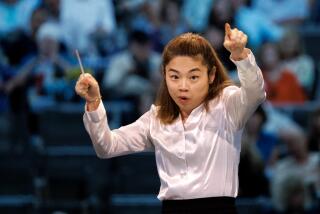MUSIC REVIEW : Bach, Brown Potent Team Out of Doors
- Share via
The debate goes on: Does it make sense to bring chamber music to the wide-open spaces? Is the gain in listenership--Ambassador Auditorium holds 1,200 music lovers, indoors, the Hollywood Bowl, nearly 18,000 in its amphitheater--worth the loss in close-upness? Strong opinions exist on both sides of this question. In the absence of a definitive answer, one can at least pose a partial defense of the practice: Sometimes it works.
Except that a couple of small planes flew across their acoustical horizon during the evening, the Los Angeles Chamber Orchestra’s outdoor performance of Bach’s “Brandenburg” Concertos succeeded better than anyone might have predicted Friday night.
The location? Cahuenga Pass, where the Hollywood Bowl--not exactly an intimate setting--on this occasion seemed to welcome Bach’s wondrous instrumental concertos.
If the amphitheater’s skillful sound engineers proved unable to bring out inner voices the way genuine ceilings and walls in an enclosed space one-tenth the Bowl’s size sometimes can do, what one heard seemed thoroughly undistorted and often even clarified.
Give outgoing music director Iona Brown at least some of the credit for that. Since her tentative, first run-through of these six works, at Royce Hall in December, she has polished her concepts and rethought all her musical views of them. Such firm musical authority as one heard, projecting off the Bowl stage Friday, is the kind of assurance one has come to expect from Brown in everything she leads.
Reconsideration is the lifeblood of a conductor’s career. In the future, Brown may see each of these 19 movements in different lights, with different characteristics, in different tempos. What is important is not interpretive sculpture-making--nothing stays the same in life, or music--but the conviction of the moment.
From the almost lugubrious imprecations of the evening-opening Sixth Concerto--the smallest in size, and the least outgoing of the set--to the self-proclaiming brashness of the program-closing No. 2, conviction, sometimes fierce, sometimes mellow, marked all of these readings.
Along the way, Brown herself, as soloist and conductor in five of the works (she stayed out of No. 6) gave her orchestra and her audience fresh insights.
Relaxation, rather than a more-usual bumptiousness, marked her approach to No. 3, second on the program. Buoyancy, rather than stolidity, characterized No. 4. Pleasureful risk-taking, rather than merely brave apprehensiveness, made the virtuoso feats--accomplished by harpsichordist Patricia Mabee, flutist David Shostac and violinist Brown--of No. 5 all the more admirable. And, in the place of simple bravado, Brown stamped No. 2 with elegance and even a measure of diffidence.
All of the soloists seemed in top form, though some glitches marked the exposed work of trumpeter Roy Poper, in No. 2, bravely facing the chill night air, as 11 o’clock approached.
Besides Brown, Poper and Mabee, some of them were flutists Shostac and Susan Greenberg; violists James Dunham (guest principal) and Laura Kuennen; oboist Allan Vogel; and hornists Steven Becknell and Calvin Smith.
Attendance: 7,529.
More to Read
The biggest entertainment stories
Get our big stories about Hollywood, film, television, music, arts, culture and more right in your inbox as soon as they publish.
You may occasionally receive promotional content from the Los Angeles Times.










